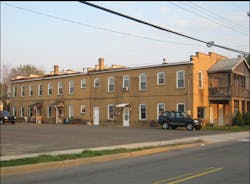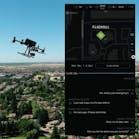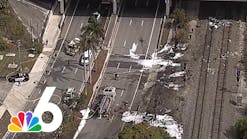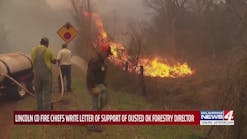Multi-tasking at Multiple Dwelling Occupancies: Ladder Companies
This month, we will look at some strategic considerations for ladder companies when they arrive at a working fire in a multiple-occupancy dwelling. These types of structures pose many severe risks over and above the routine structural fire, and the ladder company functions are not exempt. It is not my intention to discuss the typical duties and responsibilities of the ladder company; instead, we shall discuss the application of some key functions on-scene to improve the overall outcome of the incident.
A quick review of some of the basic responsibilities that are thrust upon the ladder company at any fire. They are listed below using the acronym LOVERS-U:
Laddering
While all of the above-mentioned duties are equally important to some degree, certain responsibilities have to be done immediately upon arrival and are of great importance for the initial arriving ladder company. We will discuss some of the concerns associated with performing these tasks for the company, dependent upon the situation upon arrival.
The Multiple Dwelling
We can define a multiple dwelling as a structure that houses four or more designed living spaces (see Photos 1, 2 and 3.) The stress here is on the term "designed living space." The building was constructed with a specific amount of units in mind, but that is not always the case upon arrival. These buildings come in many shapes and sizes, with a wide variety of layouts that differ from location to location. They can stand alone, be part of a row of buildings, house commercial occupants below them, and even be the result of a conversion from a previous purpose. Additionally, these structures have specific tactical concerns that must be addressed during the incident:
Variations in construction - One can find any type of construction in a multiple dwelling, including newer "hybrid" construction. Hybrid construction buildings will make use of almost all construction types and materials in the same building. Issues of extreme concern are newer lightweight construction practices, including trusses, truss joist I-beams (TJI), and Oriented Strand Board (OSB). Most of these materials are held together with glue and gusset plates and are limited in moisture content. As they dry out, they can twist, warp, and fail as they weaken.
Mixed-use occupancies - The first floor may house a commercial or mercantile occupancy, with multiple living spaces on the upper floors (see Photo 4.) The larger fire load in the first floor will severely invade upon the structural supports than if the dwelling was strictly residential.
Multiple avenues of fire spread - One of the most common causes of fire spread is due to occupant indifference, or the altering or removing of the fire containment features of the building. For example, the occupants of the dwelling might chock open the fire-rated hallway doors to the stairways located at the ends of the structure, to bring in groceries, fresh air, etc. If left open, this will allow for rapid fire spread to the upper floors of the dwelling. This is a critical area to protect, especially if the fire is on a lower floor. Additionally, there are secondary avenues of fire spread including voids, HVAC ductwork, light shafts, and pipe chases. Stacked kitchens and bathrooms will have multiple chases for utilities, with the largest chase located in the wall behind the toilet. Be sure to check this area thoroughly.
Overhead fuel load and life hazard - Fires in lower floors in these occupancies can pose a huge life safety risk and fire spread issue, as most of the fuel load and life hazard is located above the fire, directly in the path of least resistance for fire travel. Many times the fire on the floor above can be much worse and early identification of the fire spread is crucial.
Number of apartments and occupants - Owners that divide the living spaces beyond what they are designed for increase the potential for a large loss of life, both for the residents and the firefighters (see Photo 5.) One example of this is the single room occupancy (SRO). The SRO is an apartment or living space that is divided into single rooms, each with its own tenant. These could be located on any floor, including cellars, and will have an extraordinary fire load within them. This is partly because everything that the tenant owns is in one room. Should your search in these dwellings find padlocks on bedrooms and multiple doors, think single room occupancies!
At The Alarm - First Arriving Ladder
Fires in these types of occupancies will require a great deal of resources to bring these incidents to a safe and effective conclusion. Multiple ladder companies will be assigned to this incident and there are specific tasks that will have to be fulfilled based upon when they arrive. These tasks will be divided, based upon staffing and apparatus capabilities. Think about proactively assigning additional companies and personnel on the initial alarm, to limit the reflex time of responding units and improve the operational safety of the incident. Waiting too long to call in assistance puts the incident commander in a bad position. If your personnel are exhausted, and you have no tactical reserve of crews and apparatus to call upon, then you are in big trouble.
Upon arrival, the first in ladder company should be positioned in front of the fire building, to achieve maximum scrub, or have the capability to reach as many openings in the front of the structure. Beware of overhead obstructions, such as wires, that can prove to be problematic for aerial operations (see Photo 6.) Night time operations will require the truck to light up the scene for safety.
There will be an enormous amount of people trying to self-evacuate from the building. Accountability for all occupants will be difficult, but will still need to be done, to identify potential victim locations (see Photo 7.) Should the ladder arrive "heavy" (five or more members) then it would be beneficial to split the crew into two teams, to increase efficiency on-scene. Larger dwellings of four stories or more, I would suggest that the crew stay together.
The first crew will be assigned to force entry into the dwelling, allowing the engine to stretch in to find the seat of the fire, or position between the fire and the egress (interior stairway.) The second line can stretched to protect the attack stairs and inform command of this decision; many multiple dwellings have two stairways, and the other stairway may be used for egress.) Interior stairs may not be present in some occupancies, and the exterior stairs may be exposed to the products of fire leaving the dwelling (see Photo 8.) These crews can reconnisance and confirm the fire floor, gain control of the fire apartment door, advise the engine company as to the location of the fire, and direct them into position. The ladder crew should be reporting conditions inside the dwelling to the IC.
This crew then begins primary search, starting on the fire floor, moving next to the floor above, and if applicable, up to the top floor to clear the stairway of potential victims. Be sure that the search crew controls the stairway door for the evacuation route. As the crew traverses through the building, they can open up and ventilate, as long as it is coordinated with the activities of the engine. If the engine has not found the seat of the fire yet, it would not be wise to vent at this time, so operational coordination and communication are vital. Keep an eye on the progress of the operations by poking your head out of a window from time to time, checking to see if conditions on the floor below have changed at all. Once the fire is knocked down, the crew can assist with overhaul under the protection of the engine company.
The second ladder crew should look for outside vertical ventilation points (doors and windows) and prepare to open up when the order is given (see Photo 9.) Clearing the stairways will make everyone's life much easier, so think about vertical ventilation early. Breaking skylights and opening stairway hatches and roof scuttles will clear this path of travel. Ladders should be raised to provide for a second means of egress to crews working inside the building. Next, the crew should make their way to the roof, to check for stability, and look for upper ventilation points. Roof ventilation will be dependent on roof construction and location of the fire:
- If the fire is on a lower floor in a flat roof building, then the second ladder crew can enter via the upper floor and begin the top floor search, as the first crew searches the fire floor.
- If the fire is on the top floor/cockloft in a flat roof building, then the second ladder crew will be needed to perform roof ventilation operations while the first crew performs search. It is important to note that, when venting a cockloft, the roof needs to be opened prior to pulling the ceiling below; the cockloft can contain a smoldering, high heat fire, waiting for a burst of air to create a backdraft. If one occurs, it will go out the roof opening, instead of into the unit below, directly towards the firefighters.
- If the fire is on a lower floor in a peaked roof building, then the second ladder crew should focus on outside ventilation techniques and perhaps vent-enter-search while the first ladder crew performs search.
- If the fire is on the top floor/attic on a peaked roof building, then the second ladder crew will be focused on opening up the roof while the first ladder crew performs search.
In either scenario, it is important that the crew working on the roof report conditions top side to the IC, as roof integrity and fire control of the space below can signal a transition in tactical operations. Venting the roof has to be coordinated with the suppression crew as well.
At The Alarm - Second Arriving Ladder
Any of the primary functions that the first-in ladder did not get to finish should become the responsibility of the second arriving ladder company. Once they are completed, this crew can focus on additional functions that need to be addressed. The second arriving apparatus should be placed in front of the most severe outside exposure, in the event the ladder has to provide protection to the exposure. Once in position, the crew from the second ladder can split their crew, if manpower permits.
The second crew should meet up with the first crew to confirm the primary search has been completed. Once complete, the crew can begin the secondary search inside the building. Additionally, the crew can perform salvage operations inside the building under the protection of the engine company.
The second crew can throw ladders to the sides and rear of the structure, where applicable. After ladders are positioned, the crew can secure the utilities associated with the affected area of the building, and secure any controls for the HVAC systems that may be present (see Photo 10.)
The conditions for these vital functions are present at every fire. The question is not if these tasks will get done; the question is "when, and by whom?" If your normal initial response to a working fire in occupancies of this nature does not allow for the proper amount of manpower and resources on scene to commit to these tasks, there is an increased risk of serious injury to all firefighters working at this alarm.
Conclusion
Fires in multiple dwellings will require a large commitment of apparatus, personnel and equipment on the fire scene. Many of the ladder company functions are critical to overall success on the fireground. These tasks must be done quickly and effectively; therefore, make sure that the right amount of competent, trained firefighters are available on-scene to carry out these duties.
Until next month, stay focused and stay safe.
Michael P. Daley will be teaching "Firefighting Operations in Basements and Cellars" at Firehouse Expo, in Baltimore, on July 23. Later that day he will be a panelist on the "Where's The Fire? Basement Fire Tactics" podcast. On July 24 he'll be a guest on the "Preparing for Tomorrow's RIT Deployment Today" podcast.
MICHAEL P. DALEY is a lieutenant and training officer with the Monroe Township, NJ, Fire District No. 3, and is an instructor with the Middlesex County Fire Academy, where he is responsible for rescue training curriculum development. Mike has an extensive background in fire service operations and holds degrees in business management and public safety administration. Mike serves as a rescue officer with the New Jersey Urban Search and Rescue Task Force 1 and is a managing member for Fire Service Performance Concepts, a consultant group that provides assistance and support to fire departments with their training programs and course development. Mike was a panelist on Radio@Firehouse on the Successful Rescue Operations in Today's Fire Service podcast. You can reach Michael by e-mail at: [email protected].
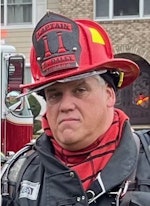
Michael Daley
MICHAEL DALEY, who is a Firehouse contributing editor, is a 37-year veteran who serves as a captain and department training officer in Monroe Township, NJ. He is a staff instructor at multiple New Jersey fire academies and is an adjunct professor in the Fire Science Program at Middlesex County College. Daley is a nationally known instructor who has presented at multiple conferences, including Firehouse Expo and Firehouse World. His education includes accreditations as a Chief Training Officer and a Fire Investigator, and he completed the Craftsman Level of education with Project Kill the Flashover. Daley is a member of the Institution of Fire Engineers and a FEMA Instructor and Rescue Officer with NJ Urban Search and Rescue Task Force 1. He operates Fire Service Performance Concepts, which is a training and research firm that delivers and develops training courses in many fire service competencies.
